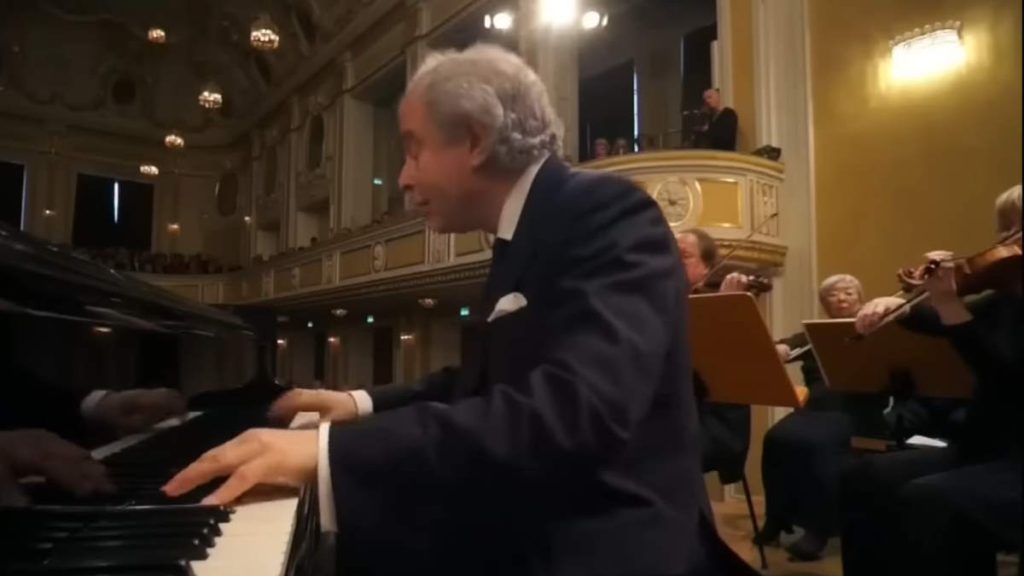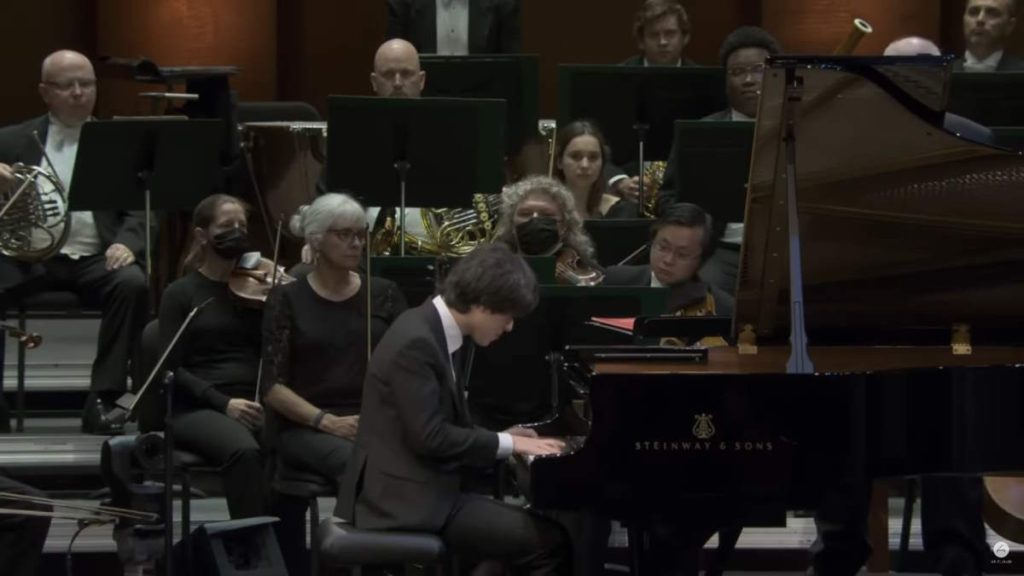Accompanied by the Deutsche Radio Philharmonie (German Radio Philharmonic Orchestra), the Finnish pianist Antti Siirala performs Wolfgang Amadeus Mozart’s Piano Concerto No. 22 in E-flat major, K. 482. Conductor: Pietari Inkinen. This performance was recorded at the Saarbrücken (Germany) Congress Hall on September 12, 2021.
Mozart’s Piano Concerto No. 22
Mozart completed the Piano Concerto No. 22 in E-flat major, K. 482, on December 16, 1785, during a period when he was reaching the peak of his popularity in Vienna. At this time, he was also working on the score for “The Marriage of Figaro,” an opera that would soon achieve immense success. The following spring, the opera became so popular that Emperor Joseph II had to limit the encores of individual numbers during performances to maintain the flow of the show.
During this period, while opera was considered the most prestigious genre, piano concertos were the foundation of Mozart’s career. His performances of his own concertos were highly sought after. Michael Kelly, an Irish tenor who originated the roles of Basilio and Don Curzio in “The Marriage of Figaro,” provided a vivid account of Mozart’s piano technique, describing his exceptional feeling, rapid fingerwork, the strength of his left hand, and the inspired nature of his modulations.
Mozart likely performed Concerto No. 22 at least three times during his life: twice shortly after its completion and again during a series of subscription concerts the following Lent. This concerto, like many of Mozart’s works, showcases his formal perfection and melodic brilliance. However, it is particularly distinguished by its colorful woodwind writing. Mozart replaced the usual oboes with clarinets, an innovative choice that adds a unique warmth and richness to the orchestral texture.
The concerto’s orchestration is sophisticated, featuring intricate dialogues between the piano and various orchestral instruments. The inclusion of clarinets contributes to the concerto’s distinctive sound, offering a mellow and inviting timbre. The thematic material throughout the concerto is memorable and beautifully crafted, reflecting Mozart’s ability to balance technical demands with expressive depth.
Mozart’s Piano Concerto No. 22 remains a favorite among performers and audiences alike. Its intricate interplay between soloist and orchestra, combined with its innovative use of instrumentation, exemplifies Mozart’s genius. This concerto is a testament to his ability to blend virtuosity and artistry, making it a masterpiece in the piano concerto repertoire that continues to captivate listeners to this day.
Movements
1. Allegro
The first movement of Mozart’s Piano Concerto No. 22, marked Allegro, begins with an orchestral introduction that sets the stage for the entire movement by presenting the main themes. The opening idea is attention-grabbing, with a drumroll-like motif that transitions smoothly into a more lyrical melody played by the violins. This contrast between the dramatic and the lyrical immediately captures the listener’s interest.
When the piano enters, it introduces a new theme of its own, adding another layer of complexity to the musical conversation. However, this theme is soon interrupted by the return of the drumroll figure, creating a sense of anticipation and continuity. The piano then transforms the transitional passage with an expressive episode in a dark, minor key, providing an emotional depth that contrasts with the initial brightness of the movement.
Following this expressive passage, the second theme that the violins introduced in the orchestral introduction is notably absent. Instead, the soloist takes the lead with a completely new theme, adding an element of surprise and innovation to the movement’s structure. This departure from the expected theme keeps the listener engaged and highlights Mozart’s creativity.
An orchestral tutti follows, leading into a more unstable, developmental section. This part of the movement features virtuoso arpeggios for the piano, which pass through numerous keys, showcasing the soloist’s technical prowess. This searching and exploratory music eventually settles on a brief reminiscence of the piano’s second theme, setting the stage for the return of the drumroll theme in the home key.
The transition, now free of the minor-key disturbances that characterized the earlier passages, leads seamlessly to the orchestra’s original second theme from the introduction, played by the soloist for the first time. This moment of resolution is followed by a reprise of the soloist’s own theme, creating a cohesive narrative within the movement.
An ensuing orchestral passage builds tension as it leads to the cadenza, an extended solo passage that Mozart would have improvised during his own performances. Since Mozart never wrote this cadenza down, performers today must supply their own, allowing for personal interpretation and creativity. After the soloist’s final trill, signaling the end of the cadenza, the orchestra returns to bring the movement to a spirited and triumphant close.
2. Andante (Variations)
The slower second movement of Mozart’s Piano Concerto No. 22, marked Andante, is the emotional core of the concerto. This movement, characterized by its melancholy and introspective nature, was notably well-received during an early performance. Mozart’s father, Leopold, reported that the Andante was particularly favored by the audience, who demanded a rare encore of the piece.
The movement begins with the strings alone, introducing the expressive main theme, which is steeped in a sense of sadness and reflection. This theme sets the tone for the entire movement. When the piano enters, it takes up this theme, presenting a variation that deepens the emotional landscape. The variation played by the piano is delicate and nuanced, highlighting the instrument’s ability to convey subtle shifts in mood.
However, this theme and variations approach is soon interrupted by the woodwinds, which attempt to lift the somber atmosphere with a contrasting melody in a major key. This interjection provides a brief respite from the prevailing melancholy, adding a layer of complexity to the movement’s emotional narrative.
Despite the woodwinds’ effort to brighten the mood, the piano and strings insist on returning to another variation of the gloomy main theme. This persistence reinforces the movement’s introspective character and emphasizes the depth of feeling expressed in the music. A duet for flute and bassoon once again tries to intervene with a new major-key theme, offering a hopeful contrast. Yet, the piano and orchestra respond emphatically, reasserting the main theme’s dominance.
In the final section of the movement, the woodwinds join the piano in a beautiful coda, ultimately acquiescing to the dark mood established earlier. This coda is achingly beautiful, blending the timbres of the piano and woodwinds in a poignant conclusion that leaves a lasting impression on the listener.
3. Allegro
The third movement of Mozart’s Piano Concerto No. 22, marked Allegro, brings a bright and joyous conclusion to the piece, immediately dispelling the somber mood of the Andante. This finale is characterized by its rondo form, where the main theme alternates with contrasting episodes, but Mozart introduces several delightful surprises within this structure.
The movement opens with a lively and sunny main theme, radiating energy and cheerfulness. After this dancing theme is established, the music pauses as the strings introduce a simple, pulsing accompaniment. Above this gentle backdrop, the soloist plays a delicate and exquisite melody, offering a moment of serene beauty.
Rather than returning directly to the main theme, Mozart transitions to a third melody, which is broadly lyrical and singing in character. This unexpected shift adds depth and variety to the movement, showcasing Mozart’s inventive use of form and melody.
The main theme reappears, but it is soon transformed into a more tumultuous developmental section. This section explores different keys and textures, adding a sense of drama and excitement. The development suddenly halts with a cadenza, where the soloist takes the spotlight, displaying virtuosity and creativity.
As if entering a dream world, the soloist then leads into a slow Andante cantabile section featuring the woodwinds. This serene interlude contrasts beautifully with the preceding excitement, adding a layer of lyrical introspection.
Another cadenza follows, seamlessly returning to a reprise of the main theme and the broad, lyrical melody introduced earlier. This cyclical return provides a sense of unity and cohesion to the movement.
As the concerto approaches its joyful conclusion, the main theme reappears once more. Just when it seems the movement is about to end, the music pauses, and Mozart briefly revisits the delicate melody from earlier, as if playfully reminding the listener of its beauty. This whimsical touch exemplifies Mozart’s characteristic wit and charm.
The concerto then bounds to its joyful and spirited end, leaving the audience uplifted and exhilarated. The third movement of Mozart’s Piano Concerto No. 22 is a masterful blend of structural ingenuity, melodic richness, and emotional contrasts, bringing the concerto to a satisfying and exuberant close.
Sources
- Piano Concerto No. 22 (Mozart) on Wikipedia
- Piano Concerto No. 22 in E-flat major, K. 482 (Mozart, Wolfgang Amadeus) on the International Music Score Library Project website
- “Something Rare: Mozart’s Piano Concerto No. 22 in E-flat major, K. 482” on the Houston Symphony’s official website
- “Mozart’s Piano Concerto No. 22, in E-flat, K. 482” on the L.A. Phil website

